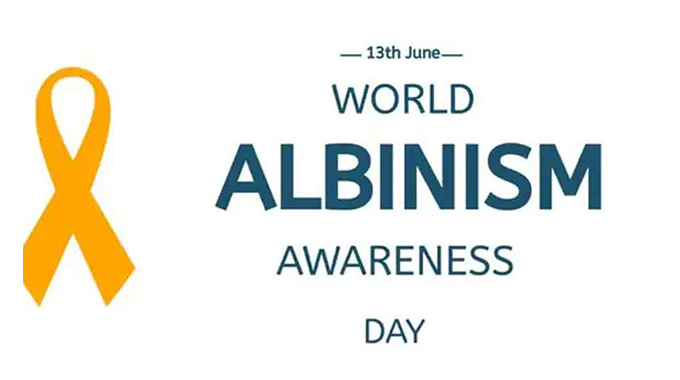Albinism strength beyond all odds

WHILE growing up, “some people treated me as less of a human being because they believed I had supernatural powers,” Moses Swaray told Africa Renewal in an interview in 2018. On the 13th of June the world commemorated International Day for Albinism. On December 18, 2014, the United Nations General Assembly adopted a resolution establishing 13 June as the International Albinism Awareness Day.
“Strength Beyond All Odds” is the theme for this year’s International Albinism Awareness Day.
The theme was chosen by the United Nations to:
Highlight the achievements of people with albinism around the world.
-Show that people with albinism can defy all odds.
-Celebrate how people with albinism worldwide meet and exceed expectations in all domains of life.
-Encourage everyone during this time of a global pandemic to join the global effort to #BuildBackBetter
Albinism is a rare, non-contagious, genetically inherited difference present at birth. In almost all types of albinism, both parents must carry the gene for it to be passed on, even if they do not have albinism themselves. The condition is found in both sexes regardless of ethnicity and in all countries of the world. Albinism results in a lack of pigmentation (melanin) in the hair, skin and eyes, causing vulnerability to the sun and bright light. As a result, almost all people with albinism are visually impaired and are prone to developing skin cancer. There is no cure for the absence of melanin that is central to albinism.
The condition has a prevalence as high as 1 in 1 000 reported for select populations in Zimbabwe.
The lack of melanin means persons with albinism are highly vulnerable to developing skin cancer. In some countries, a majority of persons with albinism die from skin cancer between 30 and 40 years of age. Skin cancer is highly preventable when persons with albinism enjoy their right to health. This includes access to regular health checks, sunscreen, sunglasses and sun-protective clothing. In a significant number of countries, these life-saving means are unavailable or inaccessible to them. Consequently, in the realm of development measures, persons with albinism have been and are among those “left furthest behind.”
Due to a lack of melanin in the skin and eyes, persons with albinism often have permanent visual impairment. They also face discrimination due to their skin colour and as such they are often subject to multiple discrimination on the grounds of both disability and colour.
Albinism is still profoundly misunderstood, socially and medically. The physical appearance of persons with albinism is often the object of erroneous beliefs and myths influenced by superstition, which foster their marginalisation and social exclusion. This leads to various forms of stigma and discrimination.
In some communities, erroneous beliefs and myths, heavily influenced by superstition, put the security and lives of persons with albinism at constant risk. These beliefs and myths are centuries old and are present in cultural attitudes and practices around the world.
The United Nations Human Rights Council adopted a resolution in 2013 calling for the prevention of attacks and discrimination against persons with albinism. Moreover, in response to the call from civil society organisations advocating to consider persons with albinism as a specific group with particular needs that require special attention.
While it has been reported that persons with albinism globally face discrimination and stigma, information on cases of physical attacks against persons with albinism is mainly available from countries in Africa.
Persons with albinism face more severe forms of discrimination and violence in those regions, where the majority of the general population are relatively dark-skinned. In other words, a greater degree of contrast in pigmentation often gives rise to a greater degree of discrimination. That appears to be the case in some sub-Saharan African countries where albinism is shrouded in myth and dangerous and erroneous beliefs. The figures on violations against persons with albinism are telling. There have been hundreds of cases of attacks and killings of persons with albinism reported in 28 countries in Sub-Saharan Africa in the past decade. The attacks have several root causes including ignorance, long-standing stigma, poverty and most abhorrently, harmful practices emanating from manifestation of beliefs in witchcraft. The alarming reality is that these horrendous practices continue today.
The manner in which discrimination faced by persons with albinism manifests itself, and its severity, vary from region to region. In the western world, including North America, Europe and Australia, discrimination often consists of name-calling, persistent teasing and bullying of children with albinism. Little information is available from other regions such as Asia, South America and the Pacific etcetera.
However, some reports indicate that in China and other Asian countries, children with albinism face abandonment and rejection by their families.
The worst expression of discrimination against persons with albinism is their dehumanisation, which lays the foundation for horrifying physical attacks against them. Because some believe that they are magical beings or ghosts, they mutilate or even kill them, so their body parts can be used for witchcraft rituals. There is deep need to demystify the condition and end discrimination.
Secretary General of the UN in his message said “I take this opportunity to urge all nations and communities to protect and fulfil the human rights of all persons with albinism and provide necessary support and care.”
-Adapted from the United Nations 2021 international albinism page. #BuildBackBetter.











Comments